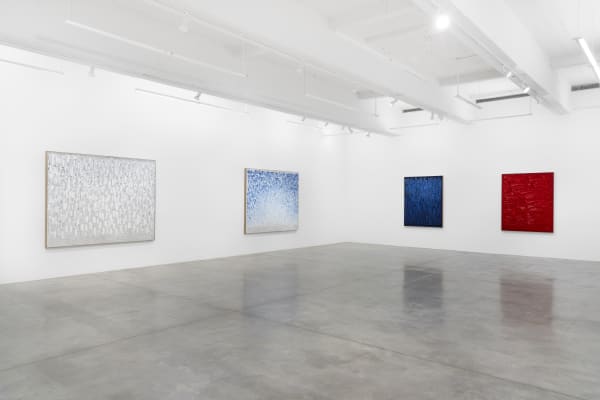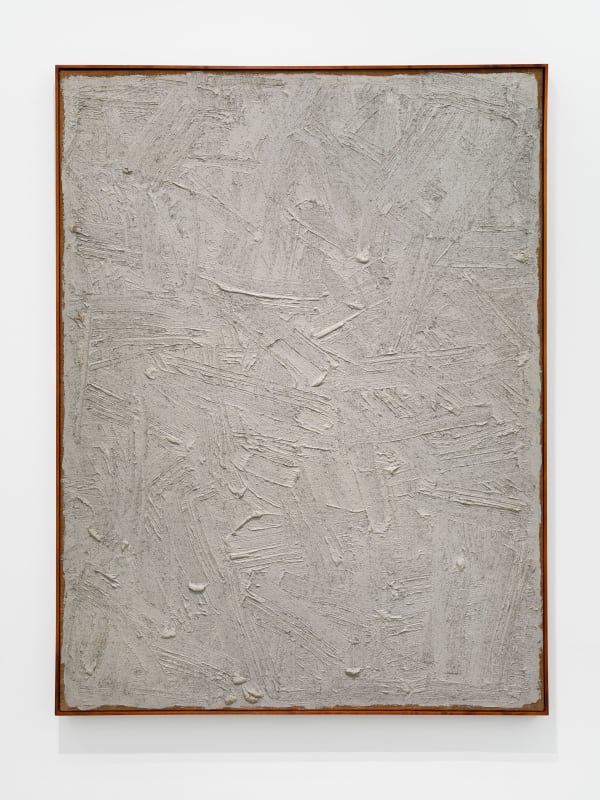Ha Chong-Hyun: 50 Years of Conjunction
Tina Kim Gallery is pleased to announce Ha Chong-Hyun: 50 Years of Conjunction, a solo exhibition presented on the 50th anniversary of the artist’s widely celebrated Conjunction series. On view from November 7 - December 21, 2024, the exhibition will highlight major works from this signature series as it developed from 1974 to the present and will celebrate the artist’s enduring exploration of painting’s material possibilities.
Beginning with the first works made half a century ago, the essential act of the Conjunction paintings is the pushing through of oil paint from the back to the front of the artwork, so that the weave and texture of the burlap fabric becomes inextricably interwoven (or “conjoined”) with the oil. Ha’s use of burlap originated from resource constraints (burlap was an easily accessible fabric, used in army sandbags and American grain shipments after the Korean War) and from his explicit desire to work with “objects from the ruins of war”. Letting the properties of the material dictate his gestures, rather than the reverse, Ha made the first Conjunction paintings by stretching hemp over the four legs of an upturned table, and pushing paint through the loose weave of the fabric to bubble and drip over the roughly textured fibers on the other side.
Conjunction arose during a critical period of rapid industrialization and urbanization in Korea, following the end of 35 years of Japanese occupation, the Korean War, and the establishment of the Demilitarized Zone between North and South Korea in 1953. Without the signing of a peace treaty and a formal end to the war, nascent optimism in the 1960s and 70s was dampened by an extended military regime that imposed strict censorship and harsh anti-communist governance. Without the freedom to protest aloud, Ha Chong-Hyun turned to abstraction as a form of silent demonstration, using the physical method of his practice and the laborious pushing of paint to express a deeply felt resistance that could not be stated explicitly. Other artists of his generation such as Park Seo-Bo, Lee Ufan, and Kwon Young-Woo expressed a similar interest in materiality and restraint, eventually coming to be known as the Dansaekhwa movement, now seen as one of the pillars of Korean modernism.
Ha’s interest in the monochrome rejected minimalism’s penchant for the smooth and seamless, always leaving evidence of his mark making across the surface. Conjunction also marked a clear departure from his early Informel period, as well as White Paper for Urban Planning, a series of brightly colored geometric abstractions that were in dialogue with an international interest in the vocabulary of line and form. The Conjunction paintings rejected the central premise and tools of painting entirely, using rudimentary hand-made tools to push and scrape his paint through the fabric, rather than daub and spread onto the surface. Early works from the series drew from the colors of everyday life in Korea, including hues from paper, ceramics, earth, traditional roof tiles, and hemp. His contemporary Conjunction works are highly gestural, vivid, and expressive, evolving the artist’s continued devotion to experimentation and inquiry in painting.
ABOUT THE ARTIST
Ha Chong-Hyun has lived and worked in Seoul since graduating from Hongik University in 1959, where he served as the Dean of the Fine Arts College from 1990 to 1994. From 2001 to 2006, Ha was the Director of the Seoul Museum of Art. Ha has exhibited in major institutional presentations around the world, including at the Solomon R. Guggenheim Museum in New York, Art Institute of Chicago, Hammer Museum in Los Angeles, the National Museum of Contemporary Art in Gwacheon, the Denver Art Museum, Song Art Museum in Beijing, the Brooklyn Museum in New York, Erarta Museum in St. Petersburg, Fondazione Mudima in Milan, as well as the Venice Biennale, Paris Biennale, São Paulo Biennale, Gwangju Biennale, and Busan Biennale, among others. His works are included in the permanent collection of various renowned institutions, such as the Museum of Modern Art in New York; Solomon R. Guggenheim Museum in New York; Art Institute of Chicago; M+ Museum in Hong Kong; National Museum of Modern and Contemporary Art (MMCA) in Korea; Tokyo Metropolitan Art Museum; the Museum of Contemporary Art in Hiroshima; and the Leeum, Samsung Museum of Art in Seoul.
ABOUT THE GALLERY
Tina Kim Gallery is widely recognized for its unique programming that emphasizes
international contemporary artists, historical overviews, and independent curatorial projects.
The gallery has built a platform for emerging and established artists by working closely with over twenty artists and estates, including Pacita Abad, Ghada Amer, Tania Pérez Córdova, and Mire Lee, amongst others. Our expanding program of Asian-American and Asian diasporic artists, including Maia Ruth Lee, Minoru Niizuma, and Wook-Kyung Choi, evince the gallery’s commitment to pushing the conversation beyond national frameworks.
Founded in 2001, the gallery opened the doors to its ground-floor Chelsea exhibition space in 2014. The gallery was instrumental in introducing Korean Dansaekhwa artists such as Park Seo-Bo, Ha Chong-Hyun, and Kim Tschang-Yeul to an international audience, establishing public and institutional awareness of this critically influential group of Asian Post-War artists. The gallery partners regularly with prominent curators, scholars, and writers to produce exhibitions and publications of rigor and critical resonance.
SALES INQUIRIES
inquiries@tinakimgallery.com
+1 (212) 716-1100
PRESS INQUIRIES
Zach Wampler | Third Eye | zach@hellothirdeye.com
+1 (212) 355-9009 x 313
-

Acts of Nullification in Park Seo-Bo and Ha Chong-Hyun
Art Asia Pacific January 20, 2025If the Korean monochrome movement known as Dansaekhwa has been typically understood as exemplifying notions of emptiness and non-action, then one has to marvel at...Learn More -

Three Essential Korean Painters Have Shows in New York Right Now. Run, Don’t Walk
Artnet December 20, 2024New York galleries are about to shutter for their holiday breaks, but before they do, can I entice you to take a pause from shopping...Learn More















